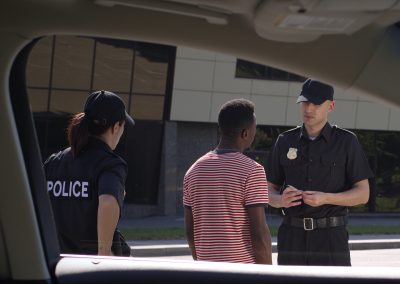By Sgt. Stefan Bjes
9 Characteristics & Tips for Contact
Editor’s note: Given increasing focus on law enforcement’s interaction with people with Autism we’re reprinting this article from an earlier Calibre posting.
When I began my law enforcement career I had never heard of Autism. As new recruits, we never received any training regarding the condition or how to safely interact with individuals who have it.
In the last two decades, Autism diagnosis have increased by nearly 300%. The Centers for Disease Control and Prevention (CDC) conducted studies on the prevalence of Autism using eight-year-old children born in the U.S. and found that 1 in 59 will have the condition.
What does this mean for law enforcement? With the incidence of Autism growing at alarming rates, it’s not a question of if you will respond to a call involving an Autistic person, but when. What complicates the matter is that there are no overt physical indicators that would alert an officer to the fact that the person they’re dealing with has Autism. Compounding that, the behaviors associated with Autism, which we’ll discuss in a minute, can be easily misinterpreted as being deceptive, furtive or generally dangerous, thus attracting elevated attention from responding officers and possibly escalating the severity of the contact.
In 2013, my two youngest sons were diagnosed with Autism Spectrum Disorder (ASD). As I studied the characteristics of the condition I wondered, is law enforcement prepared for interactions with individuals with Autism? It became my mission to make sure they were.
Autism affects three areas of brain development that include social interaction, communication and repetitive or restrictive patterns of behaviors. As officers, deficits in these areas might draw our attention and prompt us to investigate further. Typical police procedures combined with characteristics of Autism can cause misunderstandings that result in a negative interaction.
Here are the most common characteristics represented by those with Autism:
1. Lack of eye contact: Making eye contact can be difficult for people with Autism and is one of the easiest behaviors to identify. During an interaction, a person with Autism may look in the opposite direction, look through their peripheral vision, cover their eyes, or simply refuse to visually engage with the person interacting with them.
2. Lack of communication: A high percentage of persons with Autism are non-verbal or have limited verbal skills, but that doesn’t mean they can’t understand basic language. Individuals with Autism may “script,” meaning they will recite lines from books, movies or videos during a conversation. They may also repeat back precisely what is said to them, which is a phenomenon called Echolalia.
3. Repetitive actions: For persons with Autism routines are “everything.” They may include wearing specific clothing, taking a particular route, and even saying things in a very particular manner.
4. Stimming: Self-stimulatory behavior, often referred to as “stimming,” refers to repetitive actions such as hand flapping, rocking, spinning, or humming. These behaviors are used as calming techniques and used to regulate their body.
5. Sensory issues: Individuals with Autism may be hypertensive (over) or hyposensitive (under) to certain senses. Fear of loud noises, bright lights, and an aversion to touch are some of the most common sensory issues associated with Autism.
6. Lack a sense of danger: Individuals with Autism may be unable to understand the dangers of a situation. A person with Autism may be found standing in the middle of traffic or entering a body of water without the ability to swim, for example.
7. Meltdowns: Meltdowns are not temper tantrums, like those of neurotypical children. Meltdowns are usually triggered by overstimulation or the inability to communicate certain needs. Meltdowns may include aggressive behavior, screaming, headbanging and biting. The duration of a meltdown can range from a few minutes to over an hour.
8. Elopement: Elopement is wandering away from a secure setting and may be a response to overstimulation. (Think flight, in fight or flight) or the pursuit of some goal. In cases of elopement, first responders must treat these as critical incidents and utilize all available resources to locate the person as quickly as possible.
9. Personal boundaries: A person with Autism may not understand personal boundaries. They may stand too close or may attempt to touch first responder equipment. For law enforcement officers this can be seen as a threat.
The two most common types of calls for service law enforcement officers may respond to are aggressive or unusual behaviors and elopement events. A major obstacle law enforcement may encounter is not being told that the person they will be dealing with has an Autism diagnosis.
Here are some effective strategies that law enforcement should utilize when interacting with people suspected of having Autism:
1. Listen: If there are people around who know the person, listen to what they tell you. They may have important information about the person, such as they are non-verbal or are easily overwhelmed by certain situations.
2. Remember calm brings calm: If you approach the person calmly, use a calm voice and reassure them that you are there to help, they will model what they see and begin to de-escalate.
3. Use clear concise, literal commands: Avoid repeatedly asking the same questions. It takes a person with Autism longer to process what you are saying. Ask a question and allow 10-15 seconds for them to respond. Try a “first/then” approach. First, I need you to stand up, then we can walk to my car. They may not understand metaphors or sarcasm so use literal commands. Tell them what you are doing. Be specific. For example, “I am going to check your pockets” versus “I am going to pat you down.”
4. Avoid touching, if possible: A person with Autism may be hypertensive to even the slightest touch. This may create a fight or flight response. If the situation dictates that you must touch them, warn them that you are going to touch them.
5. Reduce overstimulation: Turn off lights and sirens, turn down your radio and manage your back-up officers. Limit the number of people interacting with the person.
6. Do not interfere with stimming: Stimming is a form of self-regulation. If they are stimming and it is not an officer safety concern, allow them to continue. This includes allowing a person to pace.
7. Seek alternative forms of communication: Many people with Autism utilize alternative forms of communication, such as an iPad, American Sign Language or picture exchange cards (PECS). Police Departments can seek assistance from their local school districts in designing PECS cards related to law enforcement.
8. Create a special needs registry: Registering special needs citizens with their local police department provides vital information to responding officers before arriving. Officers can be given information such as diagnosis, de-escalation strategies or a person’s favorite places (in cases of elopement) which can lead to a more safe and positive interaction.
9. Seek training: Not all states mandate training regarding Autism. We would never send our officers into a deadly force incident without proper training, why would we send them to calls with our most vulnerable citizens without proper training?
By adopting a proactive approach to educating officers about Autism, police departments can enhance officer and public safety. They can also reduce their exposure to liability by recognizing behavior/signs of Autism and responding accordingly, practicing tolerance and patience, and following procedures that ensure the safety and cooperation of a person with Autism.










0 Comments